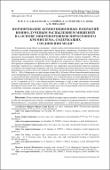| dc.contributor.author | Аль-Камали, М. Ф. С. Х. | |
| dc.contributor.author | Бойко, А. А. | |
| dc.contributor.author | Голосов, Д. А. | |
| dc.contributor.author | Доан, Т. Х. | |
| dc.contributor.author | Михалко, А. М. | |
| dc.coverage.spatial | Гродно | ru_RU |
| dc.date.accessioned | 2023-09-18T12:30:49Z | |
| dc.date.available | 2023-09-18T12:30:49Z | |
| dc.date.issued | 2022 | |
| dc.identifier.citation | Формирование композиционных покрытий ионно-лучевым распылением мишеней на основе микропорошков пирогенного кремнезёма, содержащих соединения меди / М. Ф. С. Х. Аль-Камали [и др.] // Вестник Гродненского государственного университета имени Янки Купалы. – 2022. – Т. 12, № 2. – С. 14–23. | ru_RU |
| dc.identifier.uri | https://elib.gstu.by/handle/220612/28764 | |
| dc.description.abstract | Во введении указан объект исследования – тонкие пленки, полученные ионно-лучевым распылением мишеней на основе микропорошков пирогенного кремнезема, содержащих соединения меди. Целью исследования является изучение поведения ионов меди при формировании тонких пленок методом ионнолучевого распыления мишени состава SiO2:CuO в смеси газов Ar/O2. В основной части представлены результаты исследования структурных и оптических свойств тонких пленок толщиной ~100 нм, сформированных ионно-лучевым распылением мишеней на основе микропорошков пирогенного кремнезема, содержащих соединения меди. Морфология поверхности пленки в целом показывает интегральную однородность и фактически не зависит от состава газовой среды, при этом наблюдается некоторая «зернистость» поверхности покрытия, что характерно для распыления пористых мишеней, состоящих из агломератов или доменных структур. Полученные частотные зависимости диэлектрической проницаемости пленок SiO2:CuO показали снижение диэлектрической проницаемости в интервале 10 кГц – 1 МГц. Обнаружено, что при толщине пленки SiO2:CuO менее 100 нм тонкопленочный конденсатор не всегда формируется. Основываясь на анализе оптических параметров полученных пленок в зависимости от среды распыления, высказано предположение, что в инертной среде в пленке формируется большая концентрация глобулярного CuO сфероидальной формы, а также возможно восстановление оксида меди до Cu+ и, вероятно, до Cuº, о чем свидетельствует изменение ε и tgδ, а также увеличение оптической ширины запрещенной зоны тонких пленок SiO2:CuO от 3,909 до 3,972 эВ при увеличении содержания кислорода в смеси газов Ar/O2. Полученные пленки могут быть использованы в качестве активных сред в солнечных элементах, сенсорах и других устройствах. | ru_RU |
| dc.description.abstract | In the introduction, the object of research is indicated – thin films obtained by ion-beam spraying
of targets based on pyrogenic silica micro-powders containing copper compounds. The aim of the esearch
is to study the behavior of copper ions during the formation of thin films by ion beam sputtering of a SiO2:CuO
target in an Ar/O2 mixture of gases. The main part presents the results of a study of the structural and optical
properties of thin films (~ 100 nm thick) formed by ion beam spraying of targets based on pyrogenic silica
micro-powders containing copper compounds. The morphology of the film surface as a whole shows integral
homogeneity and in fact does not depend on the composition of the gas medium, while there is some ‘‘granularity’’
of the coating surface, which is typical for spraying porous targets consisting of agglomerates or domain
structures. The obtained frequency dependences of the dielectric constant of SiO2:CuO films showed a decrease
in the dielectric constant in the range of 10 kHz – 1 MHz. It was found that when the SiO2:CuO film thickness
is less than 100 nm, a thin-film capacitor is not always formed. Based on the analysis of the optical parameters
of film accumulation depending on the sputtering medium, it was suggested that in an inert medium a large
absorption of globular spheroidal CuO is formed in the film, and copper oxide can also be reduced to Cu+ and
possibly to Cuº. It is indicated by the change in ε and tgδ, as well as an increase in the optical prohibited gap
of SiO2:CuO thin films from 3.91 to 3.97 eV with an increase in the oxygen content in the Ar/O2 gas mixture.
The resulting films can be used as active media in solar cells, sensors and other devices. | |
| dc.language.iso | ru | ru_RU |
| dc.publisher | ГрГУ им. Янки Купалы | ru_RU |
| dc.subject | Золь-гель метод | ru_RU |
| dc.subject | Мишень SiO2:CuO | ru_RU |
| dc.subject | Тонкая пленка | ru_RU |
| dc.subject | Наночастица | ru_RU |
| dc.subject | Ионно-лучевое распыление | ru_RU |
| dc.subject | Электрические свойства | ru_RU |
| dc.subject | Оптические параметры | ru_RU |
| dc.subject | Sol-gel method | ru_RU |
| dc.subject | SiO2:CuO target | ru_RU |
| dc.subject | Thin film | ru_RU |
| dc.subject | Nanoparticle | ru_RU |
| dc.subject | Ion beam sputtering | ru_RU |
| dc.subject | Electrical properties | ru_RU |
| dc.subject | Optical parameters | ru_RU |
| dc.title | Формирование композиционных покрытий ионно-лучевым распылением мишеней на основе микропорошков пирогенного кремнезема, содержащих соединения меди | ru_RU |
| dc.title.alternative | Formation of composite coatings by ion-beam spraying of targets based on pyrogenic silica micro-powders containing copper compounds | ru_RU |
| dc.type | Article | ru_RU |
| dc.identifier.udc | 666.3:621.793.18 | |
